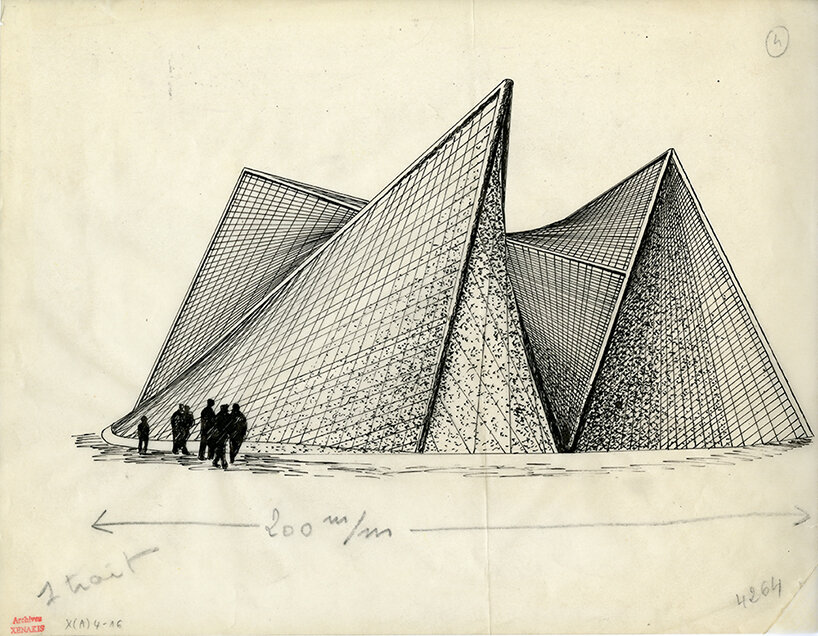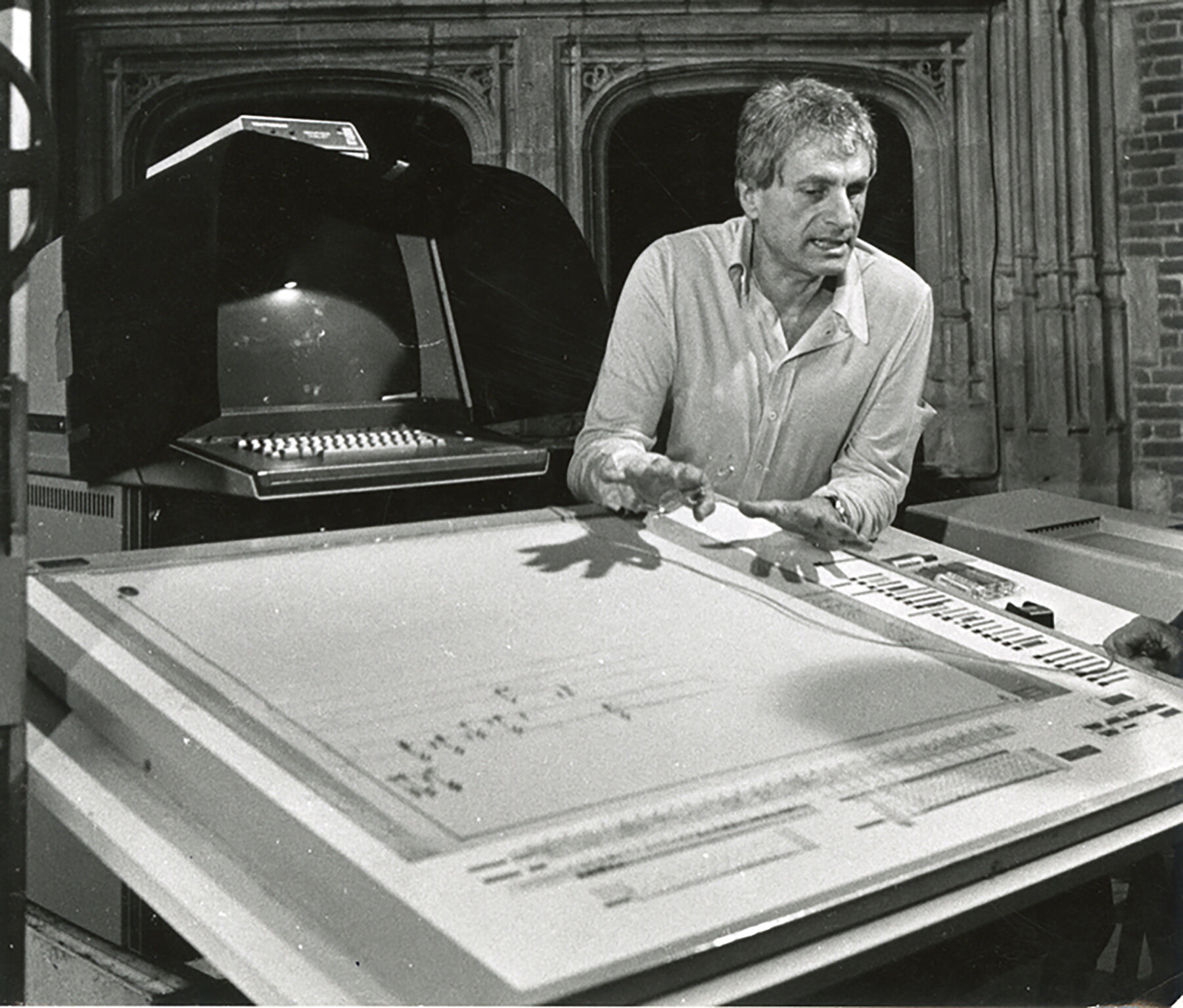EMST launches two exhibitions of iannis xenakis
The National Museum of Contemporary Art (EMST) launched Sonic Odysseys, the first major comprehensive exhibition in Greece of Iannis Xenakis (1922-2001), the avant-garde composer, music theorist, architect, engineer, mathematician, and one of the most progressive creative thinkers and cultural practitioners of the second half of the 20th century. The contemporary museum presents, in parallel, a second exhibition entitled Iannis Xenakis and Greece, which explores the controversial relationship with his ancestral homeland. Both shows opened to the public on June 29, 2023, and will run until January 7, 2024.
Co-produced by EMST and the Philharmonie de Paris, the Iannis Xenakis exhibition focuses on the most important and ground-breaking work of his visual, literary, architectural, and musical output while illuminating his personal history by contextualizing the composer in his times and the political and cultural movements that defined him as an artist. Based on the Xenakis Family archives, the exhibition parcours is designed around six chapters, centered on several major musical and architectural works. Presenting both personal and artistic material, a thematic and chronological narrative thread highlights his rich, expansive creative vision, invites the visitor to gain insight into his tumultuous personal history, reveals the multitude of his ecumenical interests through the recreation of his library, and takes us on a journey of Xenakis’s unique universe as we discover his sweeping sound masses and ultra-modern multi-dimensional spatial and musical universes.

Iannis Xenakis: Sonic Odysseys | installation view (detail): Diatope de Beaubourg, 1977 (arch. model)
courtesy Rijksmuseum | image © Paris Tavitian
sonic odysseys: from composer to architect & mathematician
In the 1950s, Xenakis broke the boundaries of contemporary music and devised a unique musical genre. Instantly recognizable despite being in constant reinvention and revolution, his radical music is, in essence, a reference to antiquity, an ode to nature and the elements, a tribute to modernism at its most extreme, and is visionary in its use of technology. Though widely acclaimed internationally, his work has yet to be presented in such an extensive way to date in Greece, and the major exhibition represents the avant-garde composer, architect, and mathematician’s most comprehensive body of work in Greece and worldwide. The initiative for the Xenakis exhibition at EMST (see more here) is in line with one of the museum’s missions, which is, among other things, to highlight the work of prominent or even lesser-known but significant cultural practitioners of the Greek diaspora.
Xenakis pioneered mathematical models in music, such as the application of game theory; he was – and remains – a seminal influence on the development of electronic and industrial music and one of the innovators of multi-media art. He conjoined music with architecture, creating music for pre-existing spaces but also designing spaces for specific music compositions and performances, reconfiguring the classical spatial arrangement of the orchestra. He was also one of the first to deploy computers for musical composition. The exhibition highlights the multi-faceted, multidisciplinary practice of this singular figure – a true polymath – and illuminates the breadth of his prolific oeuvre, demonstrating just how far ahead of his time he was, so unprecedented was his vision.

Iannis Xenakis at the University of Indiana (1972) | © Collection Xenakis Family
In 1947, during the Civil War and after receiving his degree in engineering from the Athens Polytechnic, Xenakis fled to Paris as a wanted man for his resistance activities, only to return 27 years later after the fall of the military dictatorship in 1974 and to receive an official pardon after nearly three decades of self-imposed exile. Until his passing in 2001, he composed over 150 works – from vocal, choral, and orchestral, to chamber and solo music for piano, strings, and percussion – as well as electronic music is written on the UPIC, a computerized musical composition tool he devised that could translate graphical images into musical results.
Xenakis also left behind a small but seminal architectural oeuvre produced while working with Le Corbusier at the latter’s studio in Paris in the 1950s. Most emblematic of these is the Philips Pavilion, which Le Corbusier charged him with, for the Brussels World’s Fair Expo 1958, with music by Edgar Varèse (his Poème Electronique), while at the entrance to the Pavilion Xenakis’ composition Concret PH, could be heard. The exhibition includes the original model of the architectural structure.

Iannis Xenakis: Sonic Odysseys | installation view | image © Paris Tavitian
organizing the major EMsΤ exhibition around six chapters
The exhibition is organized around six chapters, focusing on some of Xenakis’ most seminal musical and architectural works. A thematic and chronological narrative thread invites the visitor to absorb Xenakis’ unique world through both sight and sound. The exhibition includes 20 musical and architectural opuses, 220 original and archival documents: photos, models, scores, and personal items, as well as several audio-visual works.
ΤΗΕ FIRST YEARS: In presenting many objects from Xenakis’ collection, the exhibition provides insight into how the composer worked as well as his musical, literary, and visual references, including his interest in ancient Greek, Pre-Columbian, African, and Asian cultures. Also apparent is another major source of inspiration, nature, in the form of scores, artworks, or personal photographs. Several of Xenakis’ musical pieces, including Aïs, a painful echo of the premature death of his mother, Fotini, or O-Mega, his last opus, are shown alongside works borrowed from museum collections, images of which accompanied him throughout his life. These objects also tell the story of his birth and childhood in Romania, his school years spent at the boarding school on the island of Spetses, the resistance during the Second World War, the wound that would mark him for life, followed by his exile and the death sentence he received in absentia. All of these contributed to the formation of the Xenakian language.

Iannis Xenakis for the Pavillon Philips (1957) | © Collection Xenakis Family
PHILIPS PAVILION: The visitor is invited to (re)discover the emblematic Philips Pavilion, Xenakis’ first seminal architectural work, and his interrelated orchestral composition for 61 instruments, Metastasis, considered his first mature work, both of which are rooted in mathematics and signal the beginning of Xenakis’ artistic recognition. In addition, archival documents illustrate his encounters with Le Corbusier, Edgar Varèse, and Olivier Messiaen. Together with the Pavilion’s model, an immersive display alludes to the 1958 show, designed around images of Le Corbusier and the music of Varèse, alternating with Xenakis’ electronic piece, Concret PH, which was played at the entrance. The Pavilion consisted of nine hyperbolic paraboloids instead of flat surfaces and can be considered a precursor of ‘parametric architecture’, whereby geometric forms are designed by computers to produce complex architectural designs. The Philips Pavilion was one of the earliest so-called ‘multi-media’ works.
ALLOYS: Engineer, architect, composer, mathematician, and computer expert, Xenakis was neither one of these exclusively nor the other. Advocating for alliances between arts and sciences, his musical and architectural work reflects these different disciplines, reinforced by complementary dynamics. This chapter brings into perspective his relationship with German conductor Hermann Scherchen, who contributed to his public recognition and juxtaposes his great architectural projects with the stochastic music compositions, such as the undulating glass panels of the Couvent Sainte-Marie de La Tourette, which echo the musical matrixes of Achorripsis or Pithoprakta.

Iannis Xenakis: Sonic Odysseys | installation view (detail): books & objects from Xenakis’ personal library
courtesy Xenakis Family Archives | image © Paris Tavitian
POLYTOPES: The Polytopes – the multi-media spatial works that conjoined sound, light, and live performances – encapsulate Xenakis’ interests and skills as they combine all of these. Considered part of his mature oeuvre, the Polytopes synthesize Xenakian thought. From the French pavilion at the Montreal Exhibition in 1967 to the Mycenae Polytope or the Beaubourg Diatope, both produced in 1978, these ambitious, complex projects enabled Xenakis to reach a wider audience, who came to witness these spatialized shows that mixed electronic or instrumental sound with light installations. This section brings together architectural drawings, archive pieces, and photographs that shed light on these emblematic works, which are precursors of New Media Art or digital art today.
SPACE – TIME: If the description of Xenakis’ practice as being ‘in-time’ and simultaneously ‘outside-time’ refers to the understanding of musical time in the form of a succession of sound events or autonomous time-related segments, this notion also contains a spatial vision of the time-related sequence. Likewise, several works presented in this section radically question sound spatialization, whether by placing the person listening within the orchestra itself like, for example, Terretektorh, created in 1966 for the Royan International Contemporary Art Festival, or Hibiki Hana-Ma, which was composed in 1970 for the Tokyo Universal Exhibition and employed a complex system of speakers.
MACHINE AND DRAWING: The exhibition’s final chapter presents Xenakis’ exploration of machines and computing, an integral part of his eternal quest for the perfect tool that can both perform complex calculations and grasp the graphic representation of sound phenomena. Most emblematic of these is the UPIC synthesizer, which he created at the CEMAMu (Centre d’Etudes de Mathématique et Automatique Musicales), the computer music center founded by Xenakis in Paris in 1972 in collaboration with academics from several disciplines, including aesthetics, mathematics, computer science, philosophy, and electrical engineering. The documents and archives in this section highlight the composer’s decisive contribution to electronic sound synthesis.

Iannis Xenakis: Sonic Odysseys | installation view | image © Paris Tavitian
workshop-inspired exhibition design by flux office
The architecture/exhibition design conceived by Flux Office (Eva Manidaki and Thanassis Demiris) is inspired by the workshop environment of architectural offices, recording studios, and music rehearsal spaces of Iannis Xenakis’ time. The design of the ΕΜSΤ exhibition creates a space for visitors to experience his work in a way that provides insight into his multidimensional personality. As a viewer, one has the experience of entering a space of production and creation. Original documents and items are arranged and presented on slanted surfaces that bring to mind architectural designs and the UPIC, the computerized compositional system designed by Xenakis. The exhibition space is structured around four columns, creating an internal subspace containing display cases with the visionary’s archive and architectural props. Laboratory-style lighting fixtures that are arranged crosswise form a horizon above the showcases. The vertical pedestals form additional subspaces with sound-absorbing material that house Xenakis’s sound events.

installation view (detail): display cases showing a selection of Xenakis’ Polytopes
courtesy Xenakis Family Archives | image © Paris Tavitian
An office space diametrically opposite the entrance and in dialogue with the exhibits allows visitors to engage with reference material. An archive library has also been designed in the same section, which includes the entire contents of Xenakis’ library; books, records, objects, and musical instruments from his collection. Xenakis was an insatiable experimenter responsible for a multidimensional universe that the exhibition’s scenography aims to recognize. In parallel to Xenakis’ great architectural productions, the space setting of the show places his music at its center, with many audio-visual displays, providing insight into the artist’s profuse catalog as well as an audio soundtrack that plays in the space at regular intervals during the day.

Iannis Xenakis at The Shiraz Festival (1971), Persepolis, Iran | image © Malie Letrange
ΕΜST’s second exhibition explores iannis xenakis and greece
ΕΜΣT introduces a second exhibition on the composer entitled Iannis Xenakis and Greece, which explores the controversial relationship with his ancestral homeland. ΕΜSΤ produced the exhibition jointly with the Athens Conservatoire and the Contemporary Music Research Center (CMRC). Born in Brăila, Romania, the son of a Greek merchant, Iannis Xenakis was sent with his siblings to the Anargyrios and Korgialenios Boarding School of Spetses following the death of his mother in 1927.
Later, as a student at the Athens Polytechnic, he joined the National Liberation Front (EAM) and participated in the National Resistance. During the ‘Dekemviana’ or December events in 1944 (clashes between left-wing resistance forces and the Greek Government, royalists, and their British allies), he was wounded by an English mortar shell losing his left eye. He remained in Greece in semi-hiding before fleeing to France in 1947. Sentenced in absentia to death and then to life imprisonment, he could only return to Greece in 1974, following the amnesty granted by the then-Greek prime minister Konstantinos Karamanlis. Maintaining close ties to Greece during his long exile abroad, Xenakis’s work became widely known in the country despite his absence.

Xenakis and Greece | installation view | image © Paris Tavitian
The exhibition Iannis Xenakis and Greece draws from the extensive historical archive of CMRC. This organization was founded by Xenakis himself in 1979, along with the composer Stefanos Vassileiadis, the musicologist, teacher, and architect-urbanist John G. Papaioannou, and 22 others, which is now hosted at the Athens Conservatoire. Rare documents and items, including original handwritten letters and texts by Xenakis, articles, music scores, event programmes, photographs, recordings, videos, and various objects, such as the UPIC (the electronic composition system he invented), cast light on his multi-faceted relationship with Greece, testifying to the fact that contemporary, avant-garde music in Greece has a more extended and more sophisticated history than is widely believed.

Xenakis and Greece | installation view | image © Paris Tavitian
Visitors can follow Xenakis as he takes his first steps into the world of music and architecture and, through his letters, gain insight into his thoughts, concerns, nostalgia for his homeland, and his dreams for the future of the arts in Greece. His relationships with prominent figures in the musical milieu of Greece, such as John G. Papaioannou and composer Manos Hatzidakis, who valued and promoted Xenakis’s work during his period of self-exile in France, are set against Greece’s musical and cultural background of the time. Featured prominently are the five ‘Hellenic Weeks of Contemporary Music’, an initiative for pioneering musical creation that became a context for presenting Xenakis’s work as early as 1966.
The exhibition emphasizes Iannis Xenakis’ activities after his return to Greece in 1974 through the presentation of the Mycenae Polytope (1978) and the founding of CMRC (1979). Both are regarded as integral to realizing his musical and pedagogical vision. Through the archives of the CRMC collection, many items from which are on display for the first time, the exhibition Iannis Xenakis and Greece engenders a new reading of the tumultuous and often contradictory relationship between the artist-architect and contemporary Greece’s cultural and political environment.

Xenakis and Greece | installation view | image © Paris Tavitian

installation view (detail): display cases showing a selection of Xenakis’ Polytopes | courtesy Xenakis Family Archives | image © Paris Tavitian

Interior view of the Diatope – Beaubourg Polytope | image © Collection Xenakis Family DR

Diatope – Beaubourg Polytope (1977) | image © Pascal Dusapin

Iannis Xenakis in front of the UPIC machine (circa 1980) | © Collection Xenakis Family












exhibitions info:
organized by: The National Museum of Contemporary Art (EMSΤ) | @emstathens
locations: Athens, Greece
running dates: June 29, 2023 – January 7, 2024
exhibition design: Flux Office
— main exhibition —
name: Sonic Odysseys
location: EMSΤ Temporary Exhibitions Space – Ground floor
curators: Mâkhi Xenakis, Thierry Maniguet, Katerina Gregos
co-produced by: Musée de la Musique – Philarmonie de Paris
— second exhibition —
name: Iannis Xenakis and Greece
location: EMSΤ third floor-Project Room 2
curators: Stamatis Schizakis and Stella Kourbana
in collaboration with: CMRC Athens
exhibition design (648)
PRODUCT LIBRARY
a diverse digital database that acts as a valuable guide in gaining insight and information about a product directly from the manufacturer, and serves as a rich reference point in developing a project or scheme.









